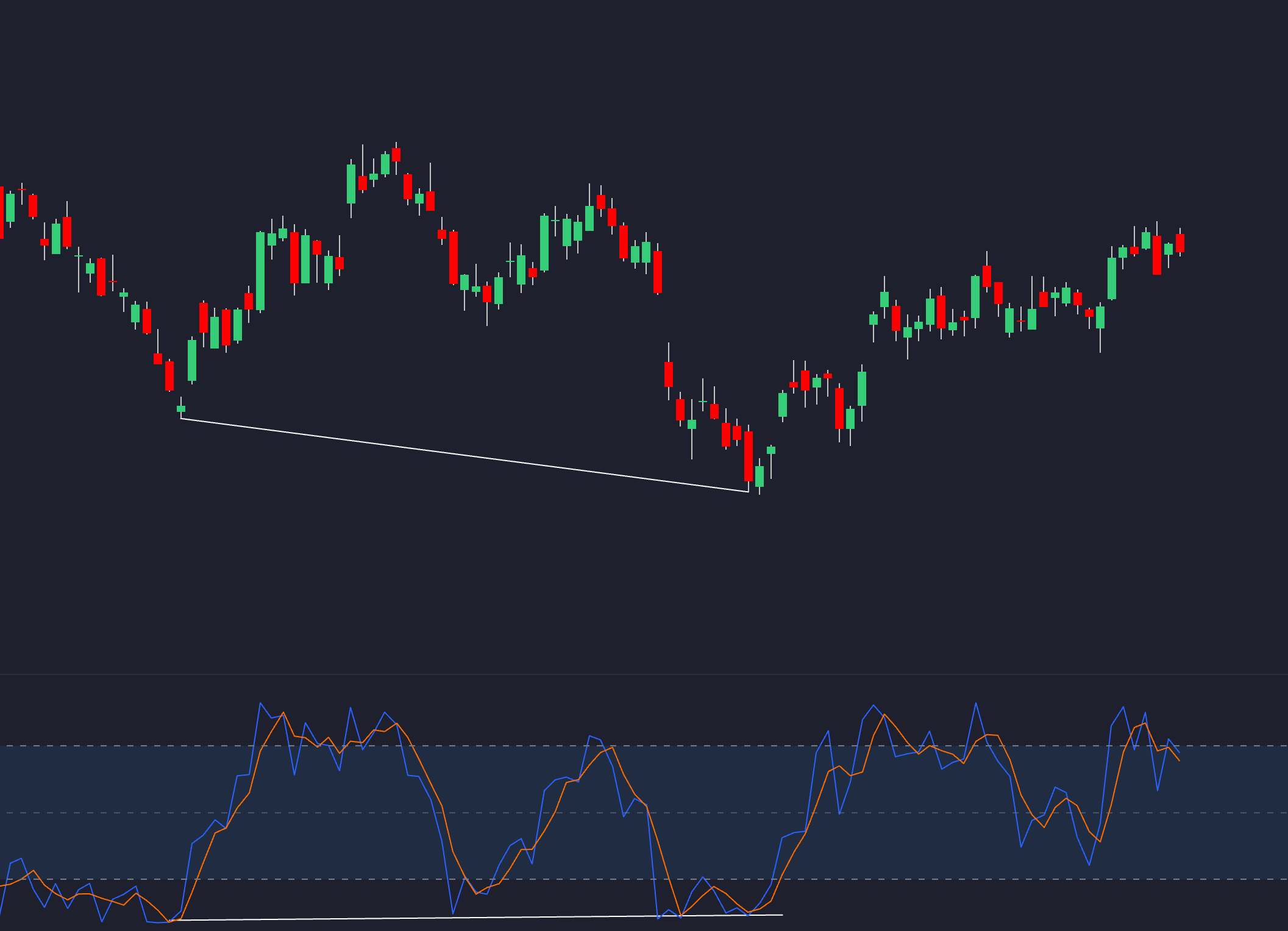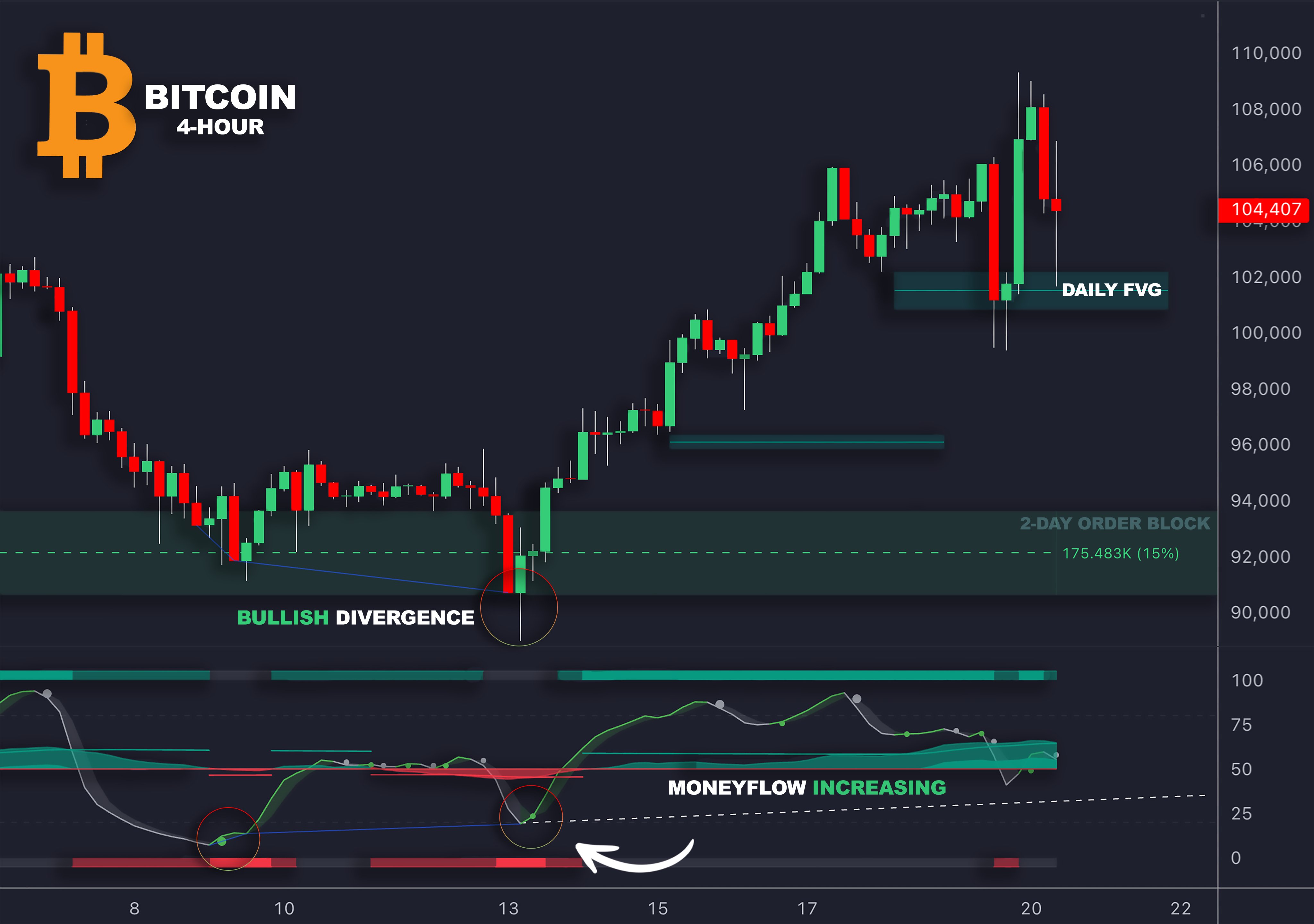Learn how stochastic divergence trading can help you identify market reversals and trend continuations with effective strategies and risk management.
Stochastic divergence trading helps traders predict market reversals and trend continuations by analyzing price movements and the stochastic oscillator. This method is ideal for spotting early trend changes, setting precise stop-loss and take-profit levels, and understanding trend strength.

Key Highlights:
- What is it? Stochastic divergence occurs when price action and the stochastic oscillator show conflicting signals.
- Types of Divergence:
- Regular: Indicates trend reversals (e.g., bullish when price forms lower lows, but the oscillator forms higher lows).
- Hidden: Suggests trend continuation (e.g., bullish when price forms higher lows, but the oscillator forms lower lows).
- Who Benefits? Intermediate to advanced stock, forex, crypto, and swing traders.
- Best Practices:
- Combine with trend analysis and price action confirmation.
- Use multiple timeframes for reliable signals.
- Tailor oscillator settings to the asset and market conditions.
- Risk Management: Place stop-losses 1.5× ATR away and aim for a 1:2 risk-reward ratio.
This guide covers everything you need to know: the basics of stochastic oscillators, spotting divergence patterns, trading strategies, tools, and risk control.
Ultimate Stochastic Oscillator Indicator Trading Strategy
Stochastic Oscillator Fundamentals
To effectively interpret divergence signals, it's crucial to understand how the stochastic oscillator works at its core.
Key Components of Stochastic Oscillators
The stochastic oscillator is built around two lines: %K and %D.
- %K (fast line): This compares the closing price to the recent price range, helping to highlight momentum shifts.
- %D (slow line): This is a 3-period simple moving average (SMA) of %K, providing a smoother representation of its movement.
These lines create the peaks and valleys that traders use to identify divergence patterns. Watching how %K interacts with price action is particularly important for spotting potential market reversals.
Adjusting the Settings
The default settings for the stochastic oscillator are 14-3-3, which break down as follows:
- 14: The number of periods used to calculate the highest high and lowest low.
- First 3: The smoothing period for the %K line.
- Second 3: The smoothing period for the %D line.
Shorter settings like 10-3-3 make the oscillator more responsive, which can be useful in range-bound markets. Longer settings, such as 21-5-5, help filter out noise in highly volatile conditions. The best configuration depends on the timeframe and the type of divergence you're analyzing.
Avoiding Common Mistakes
Traders often misuse stochastic oscillators, leading to poor decisions. Here are three common pitfalls to steer clear of:
-
Ignoring the Trend
The oscillator is most effective when combined with trend analysis. Attempting counter-trend trades without confirming price action often leads to losses, especially during strong momentum. -
Relying Too Much on Overbought/Oversold Levels
Markets can stay in extreme zones for long periods during trends. Before acting, wait for confirmation through price patterns or signals from other features. -
Using the Same Settings for Every Market
Different assets behave differently. For instance, volatile cryptocurrencies may require longer periods (e.g., 21+), while more stable forex pairs might work well with default settings. Tailor the oscillator's parameters to match the asset you're trading.
"In strong trends, the oscillator can remain in overbought or oversold territory for extended periods. Therefore, traders should not rely solely on these levels for trade decisions. Instead, they should look for additional confirmation, such as price action patterns or divergences" [2][3].
Spotting Divergence Patterns
Regular Bullish and Bearish Divergence
Regular divergence often hints at a potential trend reversal. It occurs when the price and the stochastic oscillator move in opposite directions.
- Bullish divergence happens when the price makes a lower low, but the stochastic oscillator forms a higher low. This signal is strongest when the oscillator is below 20 (oversold).
- Bearish divergence appears when the price makes a higher high, but the stochastic shows a lower high. This signal is more reliable when the oscillator is above 80 (overbought).
Hidden Divergence Types
Hidden divergence is an indicator of trend continuation and can be harder to detect than regular divergence.
- Hidden Bullish: In an uptrend, the price creates a higher low, while the stochastic forms a lower low.
- Hidden Bearish: In a downtrend, the price forms a lower high, while the stochastic shows a higher high.
Chart Reading Examples
To identify divergence patterns effectively, traders should focus on key confirmation signals:
| Divergence Type | Price Action Confirmation | Stochastic Location | Additional Signals |
|---|---|---|---|
| Regular Bullish | Support levels, bullish candlesticks | Below 20 (oversold) | Rising volume, trend line breaks |
| Regular Bearish | Resistance levels, bearish candlesticks | Above 80 (overbought) | Declining volume on highs |
| Hidden Bullish | Higher lows in an uptrend | Any level during pullback | Moving average support |
| Hidden Bearish | Lower highs in a downtrend | Any level during retracement | Moving average resistance |
To make divergence signals more reliable:
- Use multiple timeframes to confirm patterns.
- Watch for supportive price action patterns.
- Align with the broader market trend.
- Wait for candlestick confirmations at critical support or resistance levels before making a move.
These techniques will set the foundation for the divergence-based trading strategies discussed in the next section.
Trading Methods Using Divergence
Let’s expand on pattern recognition by applying practical divergence trading strategies:
Trading with Market Trends
To start, identify the main market trend using longer-term moving averages like the 50-day and 200-day. These help confirm the direction of the trend [1]. In trending markets, focus on spotting hidden divergence that aligns with the trend for better trade setups.
- In an uptrend: Look for hidden bullish divergence, where the price forms higher lows, but the stochastic indicator shows lower lows. This often signals a buying opportunity near moving average support.
- In a downtrend: Watch for hidden bearish divergence, where the price makes lower highs while the stochastic shows higher highs. This can indicate a short-selling opportunity.
| Trend | Signal | Confirmation |
|---|---|---|
| Strong Uptrend | Hidden bullish divergence at support | Price above 50 MA, ADX > 25, increasing volume |
| Strong Downtrend | Hidden bearish divergence at resistance | Price below 50 MA, ADX > 25, rising volume on drops |
| Weak Trend | Wait for trend strength confirmation | ADX crossing above 25, moving average alignment |
Trading Market Reversals
When trading reversals, regular divergence is key. Confirm these setups by looking for:
- Price action near major support or resistance levels.
- Candlestick patterns that signal reversals, like hammers or engulfing candles.
- Volume spikes, which often accompany reversal movements.
"A study of 1000 trades using stochastic divergence showed a 62% win rate in trending markets compared to 48% in ranging markets" [1].
To manage risk, place stop-loss orders 2-3 ATR (Average True Range) beyond your entry point to account for market volatility [1]. For profits, consider taking partial gains at key support or resistance levels and trail the rest of your position.
Multiple Timeframe Strategy
Using multiple timeframes can enhance your divergence trading accuracy. Here’s how to align signals across timeframes:
| Higher Timeframe | Mid-Level Timeframe | Lower Timeframe |
|---|---|---|
| Daily | 4-hour | 1-hour |
| Weekly | Daily | 4-hour |
| 4-hour | 1-hour | 15-minute |
Ensure the divergence signals match on at least two timeframes. If there’s a conflict, prioritize the higher timeframe or wait for alignment. This approach minimizes false signals and sharpens your timing.
Tools to Support Divergence Trading
Understanding divergence patterns is essential, but pairing them with the right features can make your analysis more dependable. Many traders enhance their stochastic analysis with additional resources to refine their strategies.
Divergence Analysis Powered by LuxAlgo

The LuxAlgo Oscillator Matrix simplifies divergence analysis with its advanced features, including:
- Analysis across multiple indicators and timeframes
- Automatic identification of regular, hidden, and exaggerated divergences
- Easy-to-spot, color-coded signals for quick interpretation
LuxAlgo Backtesting Features
When using stochastic divergence strategies, LuxAlgo's backtesting features offer several benefits:
| Feature | Purpose | Benefit |
|---|---|---|
| Historical Testing | Test strategies in different markets | Ensure strategy consistency |
| Parameter Tuning | Adjust stochastic settings | Fine-tune signal accuracy |
| Risk Simulation | Experiment with stop-loss setups | Minimize potential drawdowns |
To get the best results:
- Test strategies on historical data under various market conditions
- Incorporate trend and volume filters into your analysis
- Monitor key metrics like win rates and profit factors to refine your approach
Risk Control and Error Prevention
Divergence signals can be useful, but their success hinges on strict risk management - especially when dealing with unpredictable reversal patterns.
Stop-Loss and Profit Targets
Use a stop-loss set at 1.5×ATR to account for volatility while protecting your capital. Aim for at least a 1:2 risk-reward ratio. Take partial profits at critical levels and trail the rest of your position to lock in gains as the trade progresses.
Avoiding False Signals
To minimize false signals, combine divergence analysis with these techniques:
- Volume expansion: Ensure it aligns with the divergence direction.
- Multiple timeframe analysis: Look for confirmation across different timeframes.
- Price action patterns: Use these as additional validation.
Navigating High-Risk Market Conditions
Certain market conditions can increase the risks associated with relying heavily on oscillator signals, as mentioned in Common Stochastic Mistakes. These include:
- Scheduled high-impact news: Avoid trading 30 minutes before and after major announcements [6].
- Low liquidity periods: Skip trades during off-hours when price movements can be erratic.
- Strong trending markets: Stick to trades that align with the prevailing trend.
- Range-bound markets: Wait for a confirmed breakout before taking action.
During volatile events, like major economic data releases, even solid divergence signals can fail. For example, during monthly employment reports, it's often better to wait until the market stabilizes before making a move [6].
Summary and Action Steps
Key Takeaways
Stochastic divergence trading works best when paired with oscillator analysis, confirmation methods, and solid risk management practices.
Here’s what you need to focus on for better signal interpretation:
- Look for price action confirmation before committing to trades.
- Use multiple timeframe analysis to ensure signals are reliable.
- Stick to clear risk management rules, aiming for at least a 1:2 risk-reward ratio [7].
These principles, combined with the strategies and features discussed earlier, create a well-rounded trading approach.
Resources for Learning
Want to sharpen your skills? Here’s how you can dive deeper into these methods:
- Learn to spot patterns with LuxAlgo's real-time detection features.
- Test your strategies using historical data to refine your approach.
- Join the platform’s community forums to gain insights from seasoned traders.
These forums and backtesting features are excellent for improving your techniques without putting real money on the line.
Steps to Start
Ready to put these ideas into action? Follow these phases:
-
Setup Phase
- Configure alerts to detect potential divergence patterns.
-
Practice Phase
- Use a demo account to trade major currency pairs or liquid stocks.
- Log each trade with details like divergence type and key levels.
- Analyze your win rates and risk-reward ratios.
-
Live Trading Phase
- Limit risk to 0.5-1% per trade.
- Set stop-loss levels below recent swing lows or above swing highs.
- Keep detailed trading logs to review and improve your performance.
FAQs
How to trade divergence correctly?
Trading divergence effectively involves following a structured approach and using the right features. Here are the key steps:
Chart Analysis Basics
Start by drawing clear divergence lines. Connect the price and indicator swing points in the correct order on reliable charts.
Entry and Confirmation
- Wait for price action to confirm the divergence before making a trade [3].
- Ensure the swing points of the price and indicator align properly.
Managing Risk
- Place stop-loss orders slightly beyond recent swing points, depending on the trade's direction [4].
- Use the Average True Range (ATR) to determine a suitable stop-loss distance [5].
The advanced features offered by LuxAlgo can simplify this process. With built-in noise filters and multi-timeframe analysis, traders can identify patterns more effectively and confirm signals across different timeframes for better accuracy.
Adapting to Market Conditions
- Focus on hidden divergence during trends.
- Use regular divergence at the edges of ranges.
- Adjust stop-losses to account for higher volatility.



